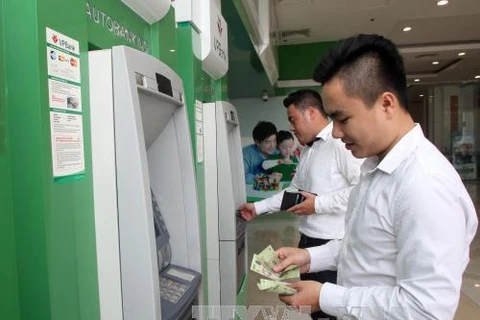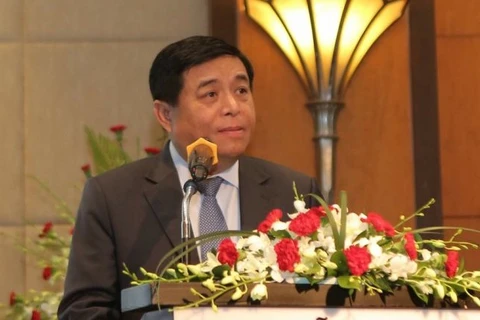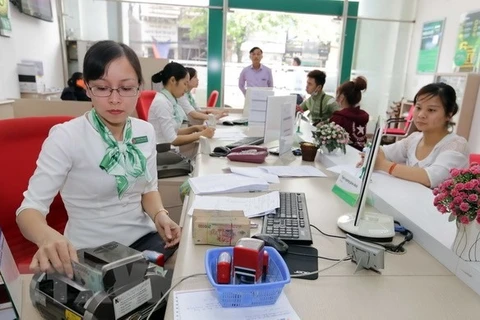Hanoi (VNA) - In the face of global market fluctuations, in 2018, the VND only devalued about 2.2-2.3 percent compared to the USD and lower than the depreciation of EUR, pound and yuan at 4.5 percent, 5.7 percent and 5.4 percent, respectively.
The last month of 2018 featured instability among international investors with a wave of stock sell-offs, causing major indexes to drop by 10-20 percent and dragging the oil price to a 16-month low.
However, the State Bank stepped in.
According to a report from Saigon Securities Incorporation (SSI), the State Bank pumped 35.23 trillion VND into the economy in December, mainly in T-bill channel when there were 28.96 trillion VND maturing and no additional issuance, putting the number of circulating treasury bills to zero.
The State Bank also injected money through this channel to nearly 6.28trillion dong.The circulated amount on the open market reached 51.06 trillion VND.
Interest rate decreases, exchange rate remains stable
In the interbank market, the interest rate of VND fell sharply in the last trading week of December. Specifically, overnight interest rates in the interbank market dropped from 4.6 percent - 4.9 percent to about 4.1 percent.
In the general market, the deposit interest rate increased sharply (from the end of October to the middle of December) also stabilised at 4.8 percent - 5.5 percent (term of less than six months), at 5.55 percent - 7.6 percent (term of six months - less than 12 months) and at 6.8 percent - 8.6 percent (12- and 13-month terms).
According to Nguyen Duc Hung Linh, director of analysis and investment advisory department for individual customers from the SSI, this showed that the State Bank and the domestic commercial banking system had good judgment and were prepared for the high liquidity demand of the market at the end of the year, in the context that the US Federal Reserve raised its interest rates on December 19.
The highlight in December was that the State Bank increased the central exchange rate by 75 VND/USD to 22,825 VND/USD (equivalent to 1.8 percent higher than 2017). However, the exchange rate at banks and in the free market fell sharply. Specifically, the official exchange rate at banks decreased by 110 VND/USD to 23,165 - 23.255 VND/USD, and the exchange rate on the free market also decreased by 130 - 135 VND/USD to 23,270 - 23,290 VND/USD.
According to the SSI's report, the amount of remittances poured into Vietnam in 2018 reached 15.9 billion USD, up 15 percent compared to the year earlier. This eased foreign exchange pressure at the end of the year with a trade deficit of 200 million USD. Hence, in 2018, the VND depreciated by 2.2 -2.3 percent against the USD and much lower than that of the EUR, British pound and Chinese yuan.
Controlling “jerk movement” situation
In the international market, unpredictable fluctuations increase. Previously, a 90-day trade war truce between China and the US brought optimism to the market, but the US's request for Canada to arrest the Vice President of China’s Huawei ramped tensions up.
Economic data in December of the world’s two largest economies show signs of deceleration, leading to recent forecasts of the global economy’s slow growth in the coming years.
In this context, global cash flows tend to find safe investment channels. In December,the gold price rose nearly 50 USD/ounce and hit a six-month peak of 1,269 USD / ounce. The 10-year US treasury bond yields officially lost the 3-percent mark when falling to 2.76 percent /year, and other terms have also dropped.
In Vietnam, information from the National Financial Supervisory Commission revealed that credit growth in 2018 reached about 14 percent - 15 percent, much lower than in the last three years. On the other hand, credit had stable growth of 15 percent, in which foreign currency credit increased by 17 percent and this is much higher than the 2.1 percent level in 2017, showing the trend of holding foreign currencies in 2018.
However, analysts still believe that maintaining the policy of keeping the interest rate of USD at zero percent and the high interest rate difference between the VND and the USD will help reverse the trend of hoarding foreign currencies and support the stability of exchange rates.
In addition, the management agency issued a message that "the focus on monetary policy management will be aimed at stabilising exchange rate through controlling the liquidity of VND”.
Linh from the SSI said investors should still be careful and if China’s yuan continues to depreciate in 2019, it will cause pressure on the VND/USD exchange rate and indirectly raise pressure on interest rates.
The official added the Vietnamese money market has already overcome the most unpredictable period; the beginning of the trade war. This will help traders aswell as management agencies have better preparation for outside challenges.
He said the volatility of USD/VND exchange rate in 2019 is expected to be approximate to that of 2018. The market will limit jerk movements which negatively affect investors' psychology.
However, he noted that the interest rate may stand at a high level, and it can increase if exchange rate pressure appears.-VNA



























